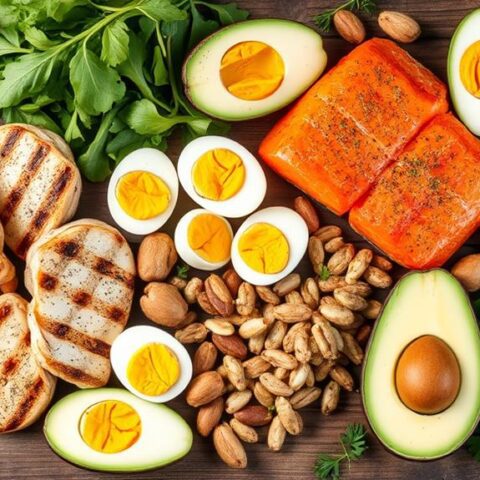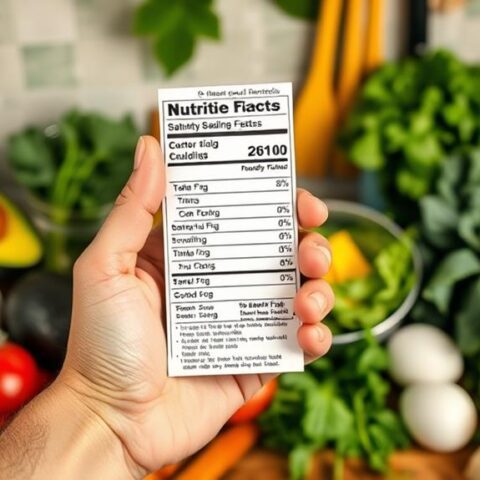
Sweet potato noodles contain 26 grams of carbs per cup, making them a moderate-carb rather than low-carb option. Their glycemic index of 46 is lower than traditional pasta, offering better blood sugar management. Proper portion control and cooking methods can help manage carb intake effectively. Pairing these noodles with low-carb vegetables and measuring serving sizes supports a balanced approach to pasta alternatives, while understanding their nutritional profile enables smarter meal planning choices.
Key Takeaways
- Sweet potato noodles contain 26 grams of total carbs per cup, with 20 net carbs after subtracting fiber content.
- While not strictly low-carb, they have a moderate glycemic index of 46, making them better than regular pasta.
- Proper portion control of 1-1.5 cups per serving is essential for maintaining lower carbohydrate intake.
- Par-boiling and sautéing sweet potato noodles can help reduce their glycemic impact while enhancing flavor.
- Using a spiralizer for consistent noodle sizes and measuring portions helps manage carbohydrate intake effectively.
Sweet Potato Noodles: Carb Content and Glycemic Impact
While sweet potato noodles have gained popularity as a pasta alternative, their carbohydrate content requires careful consideration for those monitoring their carb intake. With approximately 26 grams of carbs per cup, sweet potato noodles contain more carbohydrates than other vegetable-based alternatives, yet they offer distinct nutritional advantages. As a low-GI food with a glycemic index score of 46, sweet potato noodles break down gradually in the body, helping maintain stable blood sugar levels. Their glycemic load of 11 per serving further supports their position as a healthier alternative to traditional pasta. For those seeking to manage their carbohydrate consumption while maintaining nutritional value, sweet potato noodles can be effectively incorporated into meals by combining them with lower-carb vegetables or controlling portion sizes. The ketogenic diet greatly reduces blood glucose levels and stabilizes HbA1c, which can be particularly beneficial for those with type 2 diabetes.
Understanding Portion Sizes and Net Carbs
Managing sweet potato noodle portions effectively requires understanding both total carbohydrates and net carbs. A standard one-cup serving of sweet potato noodles contains 26 grams of total carbohydrates, with net carbs calculated at 20 grams after subtracting fiber content.
For those following a low carb lifestyle, proper portion control is essential.
- Measure portions using a kitchen scale or measuring cup for accuracy
- Consider net carbs instead of total carbs when tracking intake
- Pair sweet potato noodles with protein to reduce glycemic impact
- Keep servings to 1 cup cooked for ideal carbohydrate management
- Account for fiber content when calculating daily carb allowance
Understanding these portions helps maintain balanced meals while enjoying the nutritional benefits of sweet potato noodles, making them a sensible choice for those monitoring their carbohydrate intake.
Comparing Sweet Potato Noodles to Traditional Pasta
Since sweet potato noodles and traditional pasta differ markedly in their nutritional profiles, understanding these distinctions helps individuals make informed dietary choices.
Sweet potato noodles demonstrate clear advantages with a lower glycemic index of 46, compared to traditional pasta's range of 50-70, making them more suitable for blood sugar control. The carbohydrate content shows an even more significant difference, with sweet potato noodles containing just 27 grams per 100 grams versus traditional pasta's 75 grams.
Beyond carbohydrate considerations, sweet potato noodles offer enhanced nutritional benefits, including higher levels of vitamins A and C, and nearly double the fiber content at 4 grams per 100-gram serving.
Additionally, proper cooking methods, such as boiling, can further reduce the glycemic load of sweet potato noodles, optimizing their health benefits.
Best Cooking Methods for Lower Carb Content
To achieve ideal results with sweet potato noodles while maintaining their lower carbohydrate content, proper cooking techniques play an essential role in the preparation process.
The cooking process of spiralized sweet potato greatly impacts their final carb content and texture. When preparing boiled sweet potato noodles, the glycemic index can be reduced to 46, making them a favorable alternative to traditional pasta.
- Par-boil noodles first, then sauté for 5-7 minutes to enhance flavor while maintaining lower carb content
- Roast at 425°F for 10-12 minutes to reduce moisture and create optimal texture
- Cook noodles separately before adding to soups to prevent excess liquid absorption
- Combine with additional low-carb vegetables to enhance nutritional value
- Monitor cooking time carefully to maintain desired texture and carbohydrate levels
Alternative Low-Carb Noodle Options
While sweet potato noodles offer excellent nutritional benefits, health-conscious individuals can explore numerous other vegetable-based alternatives that provide similarly low carbohydrate content.
Spiralized vegetables like zucchini noodles and butternut squash present versatile options with minimal carbohydrates, while maintaining satisfying textures similar to traditional pasta.
Innovative alternatives such as Shirataki and Daikon noodles deliver exceptionally low glycemic impacts, making them suitable for carb-conscious diets.
For those seeking protein-rich options, mung bean and edamame noodles offer substantial nutritional value while keeping carbohydrates in check.
Additionally, cauliflower rice serves as a creative low-carb base that can be incorporated into various dishes, demonstrating how vegetable-based alternatives can successfully replace conventional pasta while supporting health-focused dietary goals.
Zucchini noodles, for instance, only contain 3g carbs per 3.5oz, offering a nutrient-rich and low-calorie option for those on a keto diet.
Tips for Incorporating Sweet Potato Noodles Into a Low-Carb Diet
Successfully integrating sweet potato noodles into a low-carb diet requires mindful portion control, with recommended serving sizes of 1 to 1.5 cups per meal to maintain appropriate carbohydrate levels. Strategic seasoning choices, such as using herbs, garlic, and olive oil instead of sugar-based sauces, can enhance flavor while keeping carbohydrate content low. Measuring portions with a kitchen scale and pre-portioning meals can help individuals stay within their daily carbohydrate targets while enjoying this versatile pasta alternative. Remember, hidden carbs can come from various sources, so it's crucial to read labels and track your intake accurately to maintain ketosis.
Portion Control Strategies
Managing portion sizes effectively forms the cornerstone of incorporating sweet potato noodles into a low-carb diet plan.
Using a spiralizer to create consistent noodle sizes helps control portions of cooked noodles, while measuring tools guarantee accurate serving amounts for meal planning.
- Measure one cup of sweet potato noodles per serving to maintain the 30-gram carbohydrate limit
- Use a kitchen scale to weigh portions before cooking for precise measurement
- Divide prepared noodles into individual containers for easy portion management
- Fill half the plate with low-carb vegetables to naturally limit noodle serving size
- Pre-portion noodles into meal-prep containers with protein sources for balanced meals
These portion control strategies help maintain the benefits of sweet potato noodles' lower glycemic index while supporting overall low-carb diet goals through mindful serving sizes.
Smart Seasoning Swaps
Smart seasoning choices amplify the natural flavors of sweet potato noodles while maintaining their low-carb benefits. Incorporating aromatic spices like smoked paprika and garlic powder enhances taste without adding significant carbohydrates, making these noodles a satisfying alternative to traditional pasta.
Low-carb sauces, such as creamy avocado dressing or natural peanut sauce, provide rich flavor profiles while keeping carbohydrate content minimal. Protein-rich ingredients, including grilled chicken, tofu, or shrimp, transform the dish into a complete meal while adhering to low-carb dietary goals.
For maximum flavor impact with minimal carb impact, fresh herbs like basil and cilantro serve as perfect garnishes, adding both visual appeal and depth to the dish's overall taste profile.
Frequently Asked Questions
Is Sweet Potato Vermicelli Low Carb?
Sweet potato vermicelli offers health benefits but isn't low-carb, containing 30g carbohydrates per serving. While better than regular pasta for health comparisons, those seeking carb alternatives should consider zucchini or shirataki noodle recipes.
Can Sweet Potatoes Be Spiralized?
Sweet potatoes can be effectively spiralized using proper techniques, creating versatile noodles for various recipes. This meal prep method preserves nutritional benefits while offering multiple cooking methods like sautéing or roasting.
Are Sweet Potato Vermicelli Healthy?
Sweet potato vermicelli offers significant nutritional benefits, including high fiber content and gluten-free properties. Various cooking methods make it versatile, while its nutrients support weight loss and healthy digestion.
Are Sweet Potato Noodles High in Carbs?
Sweet potato noodles contain relatively high carb content compared to other noodle alternatives. While offering dietary fiber benefits, they deliver approximately 27g carbohydrates per 100g serving, regardless of cooking methods.
Conclusion
While sweet potato noodles contain more carbs than zucchini or other low-carb alternatives, they can still fit into a moderate-carb diet when portioned mindfully. Their nutritional benefits, including high fiber content and vitamins, make them a healthier choice than traditional pasta. By combining proper cooking techniques, portion control, and strategic meal planning, sweet potato noodles offer a satisfying compromise for those seeking to reduce carbs while maintaining variety in their diet.










No Comments